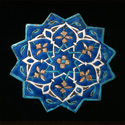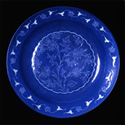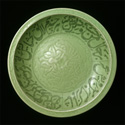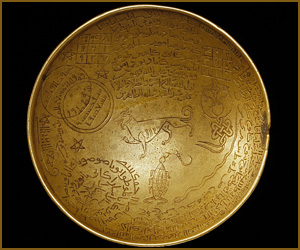Crafts and Industries

|
Lopez notes, that
amidst the agents of economic revival of the West from the 10th
century onwards, half oriental cities, which never slept: Venice
,
Amalfi, Salerno
,
and Bari, occupy the first rank.[1]The
same Italian cities, that traded with Islam and imported Islamic
trade mechanisms, playing the overwhelming part in the
introduction of
Islamic skills in crafts and industry in the Christian West
.
The inventory of industries further on will highlight this.
However, just as with sciences, or other skills, the concourse
of skilled Muslims and other Christians who lived under the
Muslims was also necessary to this transfer. Hence, the focus,
first, on the agents of transfer (the Italians
and Muslim craftsmen),
before is seen the passage of some crafts and industries from
Islam to the West.
Italian Cities and Muslim Craftsmen as Agents of Diffusion
The fundamental reason why the
Italian cities were first to convey most crafts and early
industries (just as trade mechanisms) to Western Christendom
is simple: they were the
most powerful Christian presence on Islamic soil on the economic
front. It follows the same pattern observed throughout this
work, that each and every region that made contact with Islam
was first to change, and it changed in whatever aspect it took
from Islam. Lorraine
sought and brought
astronomy and mathematics from Islam, and changed precisely in
such sciences; Salerno
got the Islamic medical
lore, and rose precisely in that field;
when England
borrowed astronomy
(through Walcher, Adelard, Petrus) or administration (from
Sicily
),
these were the very precise subjects it
pioneered; when Cracow focused on astronomy, and its
lectures made Islamic astronomy a basic requirement for
graduates and masters, it produced a Copernicus; and w
hen
the Italians
,
not the French, nor the English, traded with Islam, not the
French, nor the English, but the Italians, precisely, witnessed
the advances in their trade. And it is absolutely the same with
regard to craft and industries. As the Italians were the closest
industrial partners to Islam in North Africa, and those who took
over Muslim industry and trade in the East following the success
of the crusades, it is absolutely no surprise at all, as is
going to be shown now, that they were the first to develop
crafts and industries in the West, and that they held the
ascendancy for centuries to come in the field. The only
competition they will encounter at some point will come, not
surprisingly, from the nation which was the closest to Islamic
industries and crafts: Spain.
The
Italian presence in the Islamic land, whether west or east of
the Islamic realm, during the Middle Ages, was very powerful.
Italian cities held the most extensive Western Christian links
in North Africa, as highlighted by De Mas Latrie.[1]
The Venetians followed the Pisans and the Genoese, and soon,
under the patronage of the pavilions of the great maritime
cities, were also involved the small ports of Liguria and
Dalmatia, and the rich merchants of Tuscany and Lombardy.[2]
Sicilians, Sardinians, like the Venetian, without neglecting
Morocco
,
were, like the Genoese and the Pisans, in continuous business
rapport and interest with Tunis and `Oriental Mauritania.’ In
Tunis, Bejaia
,
and El-Mehdia, there was a large Venetian presence, the
Venetians even having changing offices, and public writers.[3]
The republic of Florence, at the same time as it built its navy,
developed its textile and silk industries, and sent consuls and
ambassadors.[4]
Genoa
and Pisa
, as
noted above, already had their special representatives, and some
impact through these extensive links has already been seen.
It
is, however, the place of the Italians
in the East, which is of
greater interest in this section. Italian cities were the most
important intermediaries between East and West, already
preceding the crusades.[5]
The `treasures’ which converged on Alexandria by sea and land
`from the two Indies, the two Ethiopias, and Arabia'[6]were
re-distributed to the Western countries through the
representatives, established in that city, of the merchants
principally of Venice
,
Amalfi, Pisa
and Genoa
.[7]It
was, however, the crusades (launched in 1095), which were to
play a central role in putting the Italians not just in contact
with Muslim trade and industry in the East, but in control of
such Muslim trade and industries, the Italians simply taking
over Muslim crafts and industries as they found them. This take
over has its origins in the crusades themselves. A major reason
behind the crusades was the great desire of the Italian cities
of Pisa, Genoa, Venice, Amalfi to extend their rising commercial
power, and capture Islamic wealth for themselves.[8]
Once the Normans captured Sicily
from the Muslims
(1060-1091), and Muslim rule was partly broken in Spain (1085f),
the western Mediterranean was freed for Christian trade; the
Italian cities grew richer and stronger, and planned to end
Muslim ascendancy in the eastern Mediterranean.[9]They
participated greatly with their fleets in the assistance of the
crusades, often such fleets playing a decisive part. It was the
Genoese ships of the Embriaco brothers which brought the
Crusaders provisions and supplies for the war, and it was to
Genoese sailors that the chroniclers attribute the success in
the capture of Jerusalem.[10]
In 1099, the Doge of Venice set out with a fleet to open up a
new and profitable trade with all the coast, and to win
privileges for his city, by aiding to conquer Caesarea and
Arsuf, Haifa, Tyre and Ascalon.[11]
From Rhodes came letters in November, 1099, announcing the
approach of these important allies; and in the June that
followed Godfrey, the crusader leader, made treaty with them.[12]If
from the 24th of June until 15th August,
the Venetian fleet would aid his army, he promised the Doge a
third part of every city taken, and a church and market in every
town, and half the spoil, and safety for the crew of any ship
wrecked on the coast; an alliance ratified on 18th of
July.[13]
The Genoese fleet equally played a great part in the taking of
Caesarea (1101), Tartus (1102), Acre and Jubail (1104) and
Tripoli (1109).[14]
Pisa and Venice played further part, too; the Pisan fleet
besieging Lattaquieh in 1099,[15]
whilst Venice lent its fleet in 1110 against Beirut and Sidon,
most particularly;[16]and
in 1123, a large Venetian squadron inflicted a severe defeat on
the Egyptian fleet, allowing the Crusaders to take Tyre the
following year.[17]Then,
once conquest was achieved, because of their very nature, or
location all along the coast, the Crusader kingdoms would have
never lasted without the support of the powerful Italian fleets
supplying them with goods and fighting men.[18]
Although they were gratified for such assistance, Genoa
,
for instance, having the honour of seeing its deeds engraved in
letters of gold in the Church of the Holy Sepulchre itself, the
Italians
were never content with
that alone. The Genoese assistance earned them a third of the
booty, and trading quarters in every town they had helped take.[19]After
the capture of Tripoli, the Genoese earned themselves a street
in that city, and the whole town of Jebail.[20]
Bertram the second count, in 1109, granted the Genoese a third
of the port of Tripoli, and the rocks of islands near it, and
free trade in the province.[21]
The Genoese quarter in Antioch consisted of at least thirty
houses, a church and a set of buildings used as warehouses and
stores.[22]
In helping capture Tyre, the Venetians earned themselves a
quarter of the city, and a district of their own in every
crusader city.[23]
Tyre became in fact the main settlement of the Venetians.[24]A
few years later we find the Venetians settling in Tripoli, and
later in Jebail.[25]The
Pisans owned property in Tripoli towards the close of the
century,[26]and
were strongly present in Acre.[27]There
was also a powerful Pisan colony in Antioch, one of its members
(Stephen) best known as a translator.[28]
All in all, the whole coastland of Syria
and Palestine, and other
major centres of trade, were under Italian control: Genoa in
Antioch, Laodicea, Caesarea, Acre, Jafa, Jerusalem, Beirut; Pisa
in Jafa, Laodicea, Tyre,
Jerusalem, and Acre; Venice
in Sidon, Tyre, Tripoli,
and Jerusalem.[29]
The
established Italian colonies in Palestine and Syria
contributed immensely to
the transfer to the West of new crafts, techniques, new methods
of building, and new ideas in the useful arts.[30]Indeed,
the Italians
have now become the
owners of industries, which were once in Muslim hands, and the
products, and skills and know how of such industries, directly
passed under their control. Thus, little surprise if woodwork
and metal work, as well as the manufacturing of glasses, which
required varied knowledge, which was unknown during the Crusade
times, was soon borrowed and spread into Europe.[31]The
glass-works of Tyre served as models to those of Venice
,
and from Syria
were in 1277 passed on the secrets of Syrian glass-making to
Venice.[32]
The finding of glass objects in former crusader castles, such as
Montfort, objects which were executed following the traditional
enamelling techniques of the Islamic East, but which show purely
Western subjects, constitute links with later Venetian work.[33]
The diverse crafts, to be seen under arts further down, were
also acquired, to the largest measure, in the same manner from
the East. When
subsequently the local Sicilians lost the skills for sugar
manufacturing, Emperor Frederick II
sent to
Marshall Ricardo Filangieri (an Italian obviously) in Tyre for
the supply of new skills.[34]
Even in coinage, with their so called `Tyre Dinars' the
Crusaders imitated Muslims from the middle of the 12th
century for over a hundred years.[35]
Other than the Italians
,
Muslim craftsmen were agents of transfer of many crafts and
industrial skills. In conflict, at all times in history, whether
during the crusades, or during the Second world War, and even
under the harshest foe, i.e the Mongols or Timur Lang,[36]
one class is always spared total annihilation: people with
practical know how. And so were Muslim craftsmen during the wars
between Christianity and Islam. In the midst of war, or
following conquest, Muslim craftsmen carried the bulk of
transfer of skills from one culture into the other. The skilled
Andalusi workforce, for instance, with its well developed
industries and sophisticated agriculture, had much to offer to
the rural and less technologically developed northern kingdoms,
Constable notes.[37]
The role of such craftsmen had dramatic repercussions on any
part of Western Christendom they were carried to. The transfer
of Muslim ceramic experts between Spain and other parts of
Western Europe directly led to the rise of Western gold lustre
ceramics, for instance.[38]
Prior to such transfer, imported pieces from the Islamic land
seemed to be located `in some exotic distant land.’[39]
All changed, when in the 14th century Muslim experts moved from
Malaga (still under Islamic control) to the suburb of Manises
(near Valencia
),
then under Christian control, and began to produce lustre-ware;
`the surrender of this professional secret to a Western land
governed by Christians had taken place,’ Schnyder notes.[40]
Manises soon developed into a leading centre in the art of
lustre faience, so much so, in 1383 its gilded and expertly
painted products enjoyed such an excellent reputation that the
Franciscan monk Eiximenes, author of a eulogy to Valencia, was
able to write that even the Pope, the Cardinals and the Princes
of the world were among its admirers.[41]Then
from there, the skills spread northwards.
Pottery decorated with the emblems of important Italian,
French and Spanish
personalities were to
follow;[42]
and the golden ceramics from Valencia achieved their widest
distribution to the furthest reaches of Europe.[43]And
wherever `the brilliant examples of the artistic ability of
Valencia arrived, they served as guidelines and ideals, strongly
influencing the Italian Majolica art of the 15th Century.[44]After
the established relations between Manises and Avignon during the
years 1362-64, we hear in 1382-85 of a certain Jehan de Valence
who was employed in the service of the Duc de Berry and who
produced painted faience tiles in Poitiers and in Bourges (in
France).[45]
The
superiority of Muslim skills is further substantiated by the
fact that everywhere under Christian rule, Muslim craftsmen were
keenly sought after. In Spain, as the re-conquest proceeded,
Muslims, masters of great skills were
allowed to retain their functions and serve the new crown;
alongside builders, paper and textile makers, manufacturers of
iron, they represented expertise of a diverse sort.[46]
Glick notes, that, in general, Christian rulers made concerted
efforts to keep Muslim owned industries going, particularly
those crafts deemed to be Islamic specialities.[47]
Thus, in 1251 Jaime of Aragon allowed the potters of Jativa to
practise their craft on the annual payment of a bezant for every
oven.[48]The
same Jaime encouraged the continuity of the paper industry in
Jativa and supported it by forbidding the making of paper by
Muslims elsewhere in the kingdom of Valencia
,
whilst Alfonso X
ordered in 1281 that no
pottery works were to be built in Cordoba unless in the Muslim
style.[49]
Groups of Muslim workers were enticed from their homes by royal
or seigniorial privilege and settled en masse elsewhere, to
develop particular industries.[50]
Muslim craftsmen, dye-masters, boatmen on the Ebro River,
leatherworkers, and providers of many kinds of service shared
their hamlets and urban quarters.[51]
Equally the barons and landlords, in Spain, valued both Muslims’
work ethic and the income it brought, and they tried to protect
this investment against church and townsmen.[52]
Muslim expertise was so critically needed that when in Murcia
Muslim weavers departed en masse, the silk industry was
destroyed, and fulling mills had to be converted by new
Christian owners to rice husking.[53]
Also both Valencian
and Sicilian Muslims
served in the respective royal armies as contingents; and both
manufactured valued weapons for the Christian armies.[54]Muslim
craftsmen of Sicily
under Christian rule
contributed to the same spread of crafts and techniques as
Muslims did in Spain.
Frederick II
had large numbers of
Muslims transported and exiled to
Lucera, and
they took with them their own arts and crafts.[55]
At the fall of Lucera fifty years later, the conquering Angevin
transported back to Naples various such Muslims for their
service.[56]In
the crusader East, European artisans who had settled in
the cities of the crusader states were unable to exercise any
lasting influence worth mentioning.[57]
In the process of sugar production, for instance, the Crusaders
found that the Syrians were not just expert at growing sugar;
they also mastered the technique of crushing it under presses,
extracting the juices, concentrating the substance on fire, then
drying it out slowly into sugar.[58]
The Crusaders took over the industry, and followed precisely the
Muslims system of production, using the same Muslim terminology.[59]At
Acre, they used Muslim prisoners in the manufacture of sugar.[60]
Large numbers of Eastern Muslims
craftsmen, skilled in many other trades, were also carried
to Europe by their new crusader masters on their return;[61]
and their impact will be particularly obvious in the following
chapter on arts and architecture.
It
is worth adding another point here, raised by Stock, who points
out, that it may be, that Bernard of Tiron, a wandering preacher
who died in 1117, founded a house specifically as a haven for
craftsmen, but the real model for change came once again from
Islam, in which the status of the artisan had changed from that
of the slave to that of the free labourer.[62]The
artisan scientist, who was considered an aberration in the
ancient world, was more a norm in Islam, artisans playing a
leading part in the transfer of techniques throughout the highly
mobile Muslim world.[63]The
importance Muslims granted their craftsmen or instrument makers
is also noted by Sarton
`in the extravagant
praise' lavished on the instrument maker: Badi al-Astrulabi.[64]
Both this attitude to the artisan and his status were eventually
transferred to Christendom.[65]Which
is also a defining landmark in the rise of industry in the West.
[1]
M.L. de
Mas Latrie: Traites de paix; op cit.
[2]
Ibid. p.84.
[3]
Ibid. p.89.
[4]
Pagnini: Della
decima di Firenze, Vol II, p. 39, 187, etc; in M.L.
De Mas Latrie: Traites; pp. 84; also preface; pp. 37;
48-9; etc.
[5]
R.S. Lopez in A.R.
Lewis: The Moslem expansion in the Mediterranean, A.D.
827-960: pp 23-29; in The Islamic World and
the West (A. R. Lewis ed) op cit;
p.30.
[6]
William of Tyre:
Historia, book XIX, in G. Sarton
: Introduction; Volume III. p.229.
[7]
G. Sarton
: Introduction; Volume III. p.229.
[8]
W. Durant: The Age of faith, op cit; p.586.
[9]
Ibid.
[10]
Z. Oldenbourg: The Crusades
; op cit; p. 295.
[11]
C.R. Conder: The Latin
Kingdom.
Op cit; p. 72.
[12]
Ibid.
[13]
Ibid.
[14]
R.H.C. Davis: A History of Medieval Europe;
Longman; London; 2nd ed; 1988. p. 271.
[15]
Z. Oldenbourg: The Crusades
; op cit; p. 295.
[16]
R.H. C. Davis: A History; op cit; p. 271.
[17]
Z. Oldenbourg: The Crusades
; op cit; p. 295.
[18]
Ibid; p. 295-6.
[19]
R.H.C. Davis: A History; op cit; p. 271.
[20]
Z. Oldenbourg: The Crusades
; op cit; p. 296.
[21]
Regesta, nos 55; 84. In C.R. Conder: The Latin
Kingdom; op cit;
p. 87.
[22]
M. Erbstosser: The Crusades
;
op cit; p. 131-2.
[23]
Z. Oldenbourg: The Crusades
; op cit; p. 297.
[24]
M. Erbstosser: The Crusades
;
op cit; p. 131-2.
[25]
C.R. Conder: The Latin
Kingdom; op cit;
p. 87.
[26]
Ibid.
[27]
M. Erbstosser: The Crusades
;
op cit; p. 131-2.
[28]
C.H. Haskins
: Studies; op cit.
[29]
M. Erbstosser: The Crusades
;
op cit; p. 131-2.
[30]
C. Singer: East and
West in Retrospect; in C.J. Singer et al:
History of
Technology
; 5 vols; vol 2; Oxford at the Clarendon; 1956; pp
753-77; p. 764.
[31]
G. Le
Bon: La Civilisation des Arabes;
op cit; p.259.
[32]
A. Y.
Al-Hassan; D.R. Hill
: Islamic Technology; op cit;
p. 33
[33]
R.Ettinghausen: Muslim decorative arts and painting,
their nature and impact on the medieval West; in
Islam and the Medieval West; ed S. Ferber; State
University of New York at Binghamton; 1975. pp. 5-26.
p. 19.
[34]
Huillard-Breholles, Hist.Dipl. Friderici II; Vol 5; pars
1; p.574. in W.Heyd: Histoire; p. 686.
[35]
Ibn al-Qalanisi; Gibb; 48; Ibn Taghribirdi; Nujum; v;
150 in C.
Hillenbrand: The Crusades
, Islamic Perspectives, op cit;.p.398.
[36]
Timur Lang, for instance, when he destroyed Damascus
and mass
slaughtered its population only spared the artisans,
whom he took to Samarkand his capital. In D. Whitehouse:
Glass
; Dictionary of the Middle Ages; op cit; vol 5;
pp. 545-8. at p. 547.
[37]
O.R. Constable: Trade and Traders; op cit; p. 4.
[38]
R. Schnyder: Islamic ceramics: A Source of Inspiration
for Medieval European Art; in Islam and the Medieval
West; S. Ferber edition; op cit; P. 34 fwd.
[39]
Ibid. p.34.
[40]
Ibid.
[41]
M. Olivar Davdi:
La ceramica trecentista en los paises de la corona de
Aragon, Barcelona
; 1952; pp. 118 fwd.
[42]
A Wilson Frothingham:
Lustreware of
Spain, New York; 1951;, pp. 15-78.
[43]
R. Schnyder: Islamic Ceramics; op cit; P. 34.
[44]
Ibid.
[45]
M. Olivar Davdi:
La ceramica trecentista; op cit; p. 135 fwd.
[46]
N. Smith: A
History of Dams
,
The Chaucer Press, London,1971,
p .103.
[47]T.F.
Glick: Islamic and Christian Spain; op cit p. 223.
[48]J.F.
Riano: South Kensington Museum Art handbooks. The
Industrial Arts
in Spain;
London; 1879; p. 163.
[49]
T.F. Glick: Islamic
and Christian Spain; op cit p. 223.
[50]
Ibid. p. 224.
[51]
R. I. Burns:
Muslims in the Thirteenth; op cit; p.65.
[52]
Ibid. p.63.
[53]
T.F. Glick: Islamic
and Christian Spain; p. 223.
[54]
R. I. Burns:
Muslims in the Thirteenth; op cit; p.101.
[55]
A. Lowe: The barrier and the Bridge, G. Bles,
London, 1972; p.92.
[56]
Ibid.
[57]
M. Erbstosser: The Crusades
;
op cit; p. 131.
[58]
Jacques de Vitry in W. Heyd: Histoire; vol2; op cit; pp.
685-6.
[59]
W. Heyd: Histoire; op cit; vol 2; pp. 685-6.
[60]
Michaud-Reinaud: Bibliotheque des croisades; IV; p. 126;
in W. Heyd: Histoire; op cit; pp. 685-6.
[61]
J.H. Harvey: `The
Origins of Gothic Architecture
,' Antiquaries Journal 48 (1968), pp. 91-4.
[62]
B. Stock: Science, Technology, op cit; p. 31.
[63]
Ibid. pp. 21 and 31.
[64]
G. Sarton
: Introduction, op cit, vol 2;
p.13.
[65]
B. Stock: Science, op cit, p. 21.
|





